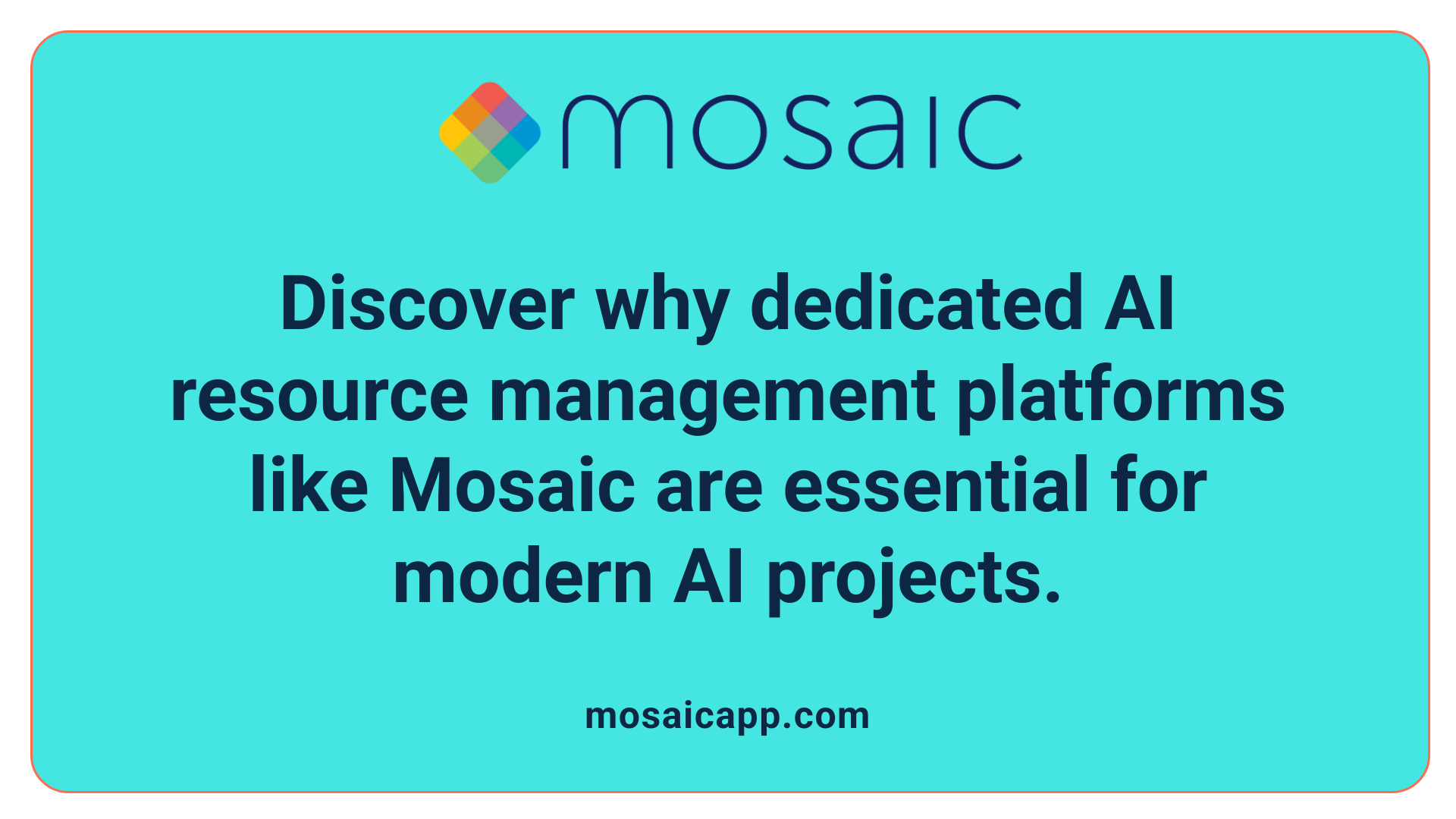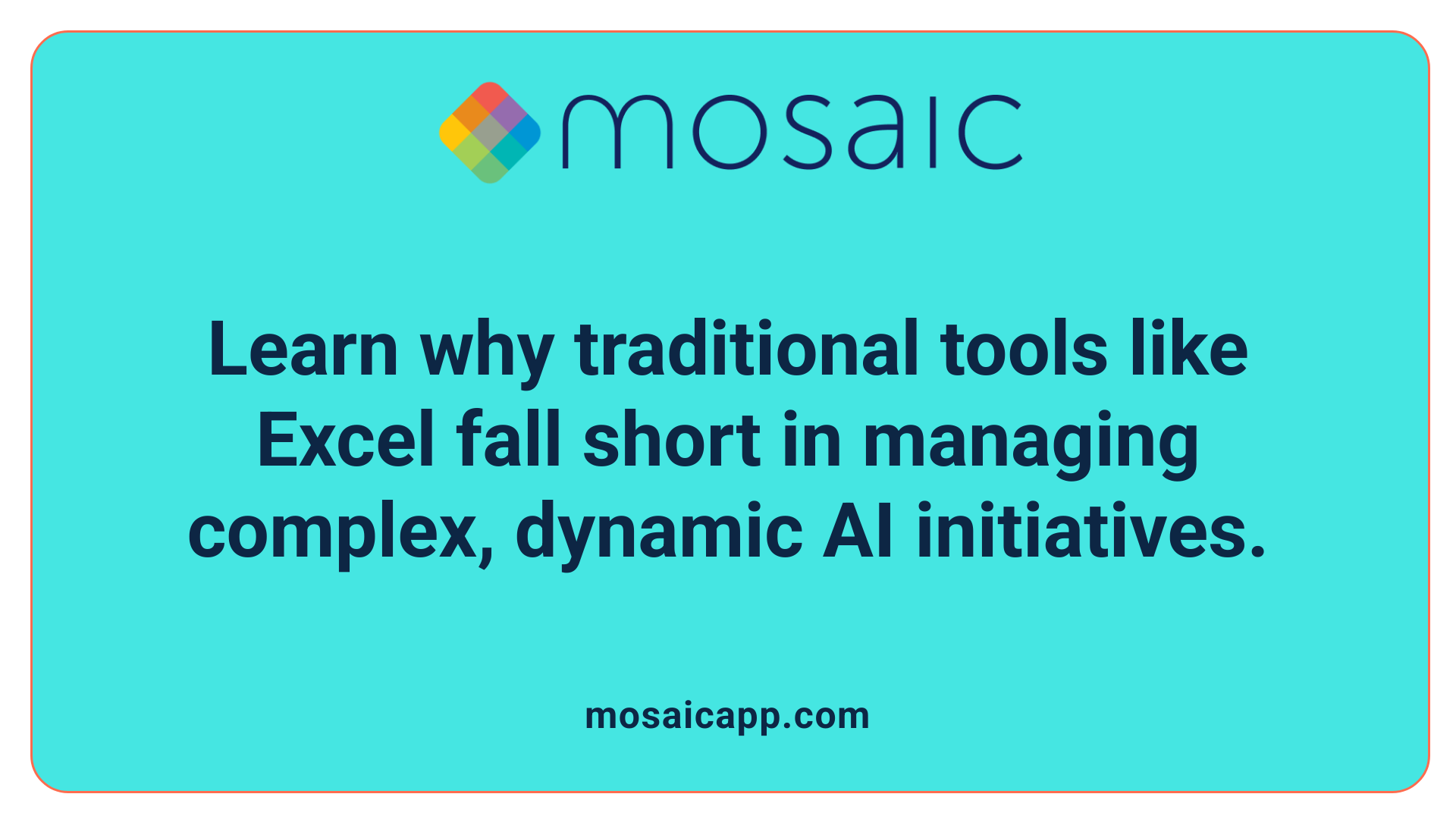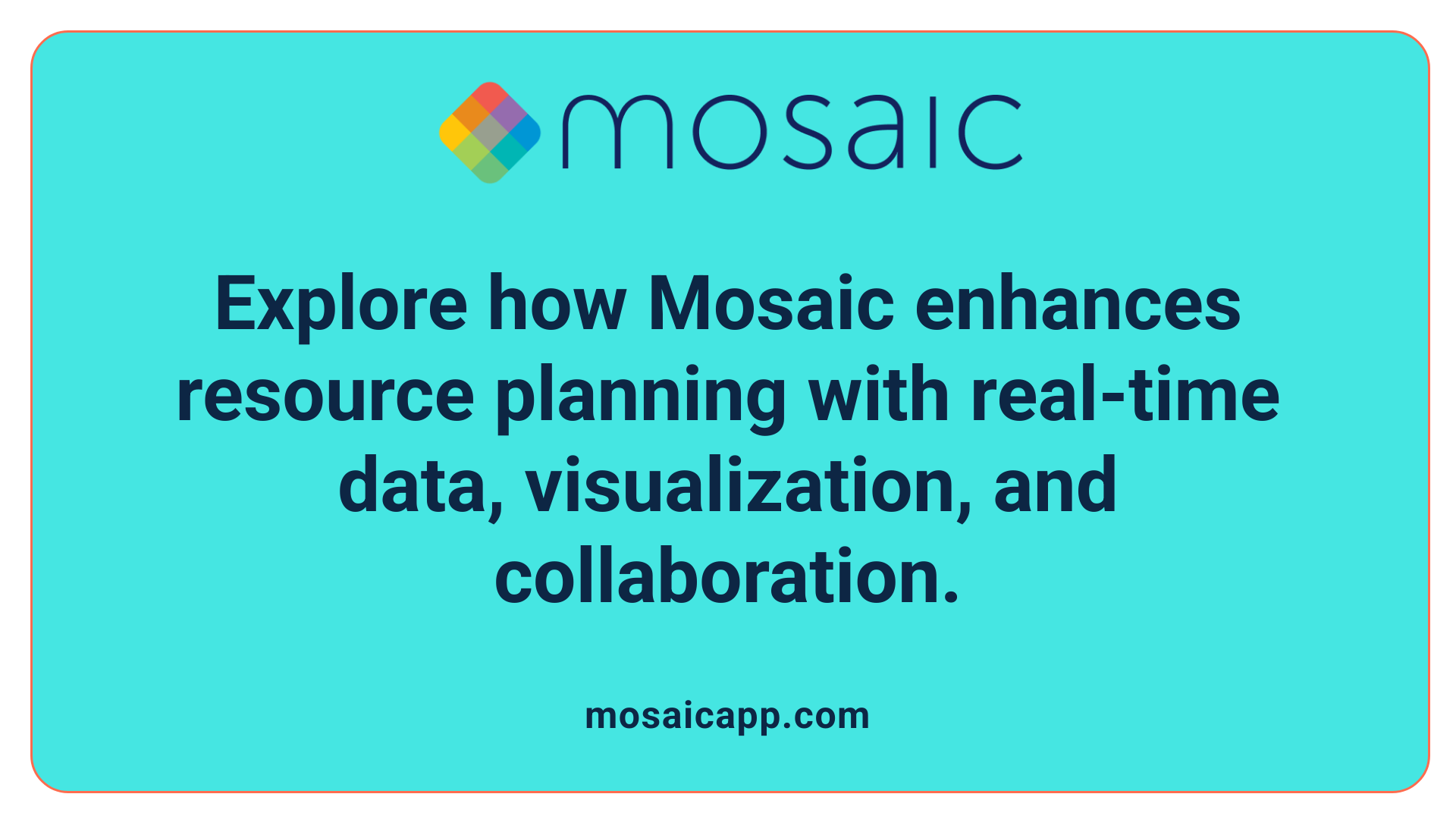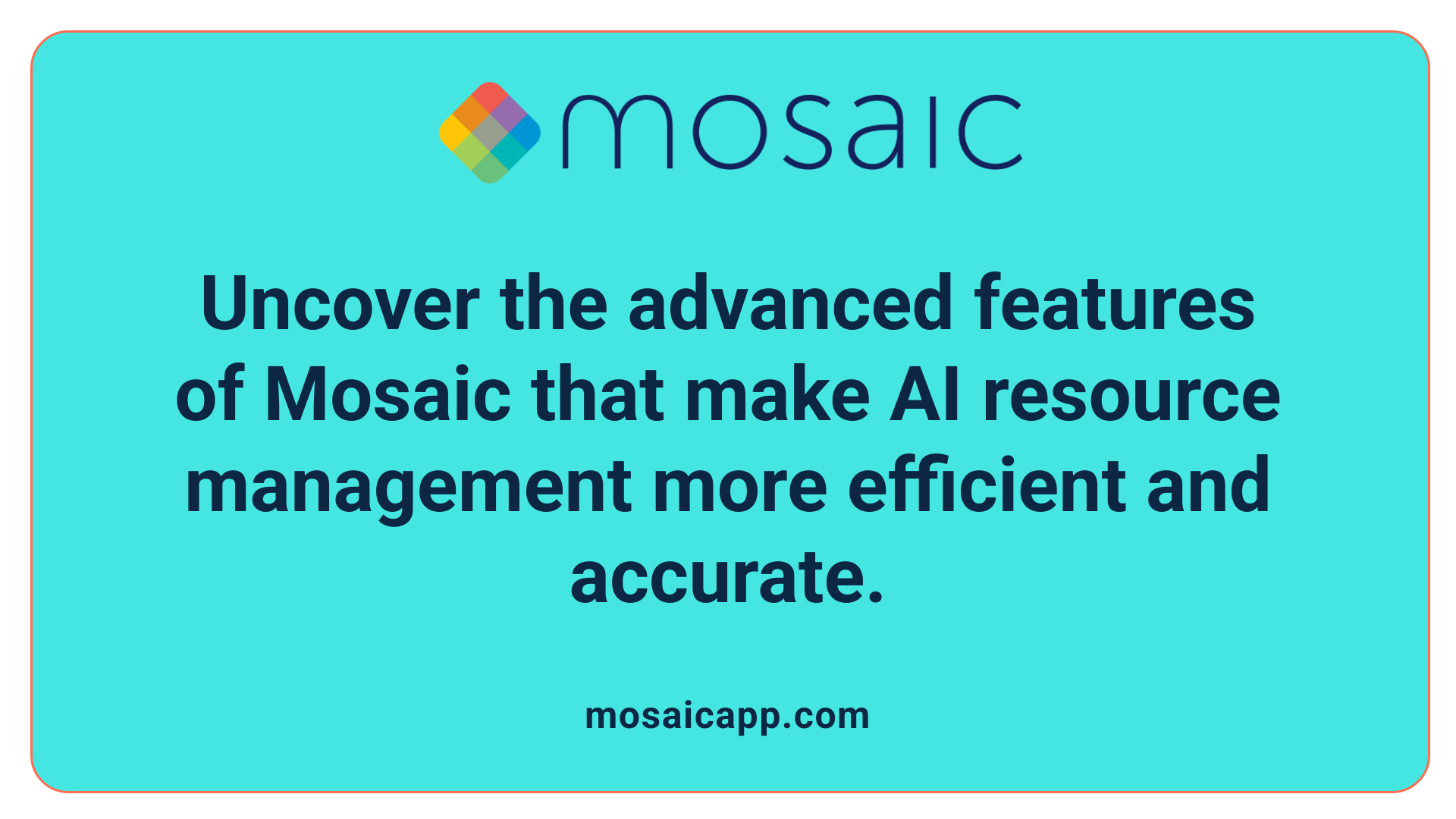Revolutionizing AI Resource Planning with Modern Tools
In an era where AI development accelerates at an unprecedented rate, organizations need robust tools to manage their resources efficiently. While traditional spreadsheet solutions like Excel have served as staple tools for decades, their limitations in handling complex, real-time, AI-specific tasks necessitate more advanced platforms. Mosaic has emerged as a transformative alternative, offering a comprehensive, specialized platform designed explicitly for AI resource planning. This article explores why Mosaic outperforms Excel, highlighting its features, advantages, and the reasons it is considered a superior choice for managing AI resources.
Understanding the Need for Advanced AI Resource Management Tools
 Managing AI projects effectively requires tools capable of handling complex, dynamic environments that traditional solutions like Excel cannot sufficiently support.
Managing AI projects effectively requires tools capable of handling complex, dynamic environments that traditional solutions like Excel cannot sufficiently support.
Excel has long been used for resource planning, but it often falls short in managing large, interconnected projects with real-time dependencies. It lacks automation, scalability, and the ability to process vast amounts of data quickly. This can lead to outdated plans, bottlenecks, and resource allocation issues that hamper project delivery.
In contrast, specialized AI resource management platforms like Epicflow incorporate features driven by intelligent automation and real-time data analysis. Such tools enable organizations to forecast workload, detect potential bottlenecks early, and adjust resources dynamically. Automated project planning and control over multi-project environments improve efficiency and help prevent cost overruns.
Especially in AI projects, where rapid iteration and model deployment are essential, the role of these advanced tools becomes even more critical. They support scenario planning, historical data analysis, and real-time tracking, ensuring projects stay on schedule and within budgets. Integration capabilities with enterprise systems further enhance their ability to adapt to complex workflows and provide a comprehensive view of resource utilization.
Overall, the shift from traditional tools like Excel to dedicated AI resource management platforms represents a significant step forward in managing the intricacies and scale of modern AI initiatives.
Limitations of Conventional Tools in Handling Complex AI Projects
 Managing AI projects involves juggling many variables, dependencies, and rapid data changes. Traditional tools like Excel, which many organizations rely on, often fall short in effectively supporting these complex environments.
Managing AI projects involves juggling many variables, dependencies, and rapid data changes. Traditional tools like Excel, which many organizations rely on, often fall short in effectively supporting these complex environments.
One major issue with Excel is the reliance on manual data entry. Users must manually update spreadsheets, which increases the likelihood of errors and inconsistencies. Static models in Excel also mean that data is often outdated quickly, making real-time decision-making difficult. This can result in misaligned project timelines, resource overallocation, and unexpected cost overruns.
Moreover, Excel struggles with managing real-time analytics, projections, and automations that are crucial in AI development. Without built-in capabilities for automatic updates or predictive analytics, teams have to spend valuable time and effort implementing external tools or custom scripts. This hampers agility and can delay critical decisions.
Security is another concern. Traditional spreadsheets lack robust security measures necessary for sensitive data involved in AI projects. They often do not meet modern standards of compliance, especially in regulated industries like healthcare or defense.
Why is Mosaic considered a better choice than Excel for AI resource planning? Mosaic is designed specifically for complex financial and operational processes, incorporating AI features such as real-time dashboards, anomaly detection, and on-demand modeling. Unlike Excel, Mosaic connects directly to various data sources, ensuring data accuracy and timeliness. Its automation capabilities reduce manual workloads, minimize errors, and allow teams to quickly analyze trends or simulate different scenarios. This tailored approach makes Mosaic a more effective and reliable tool for managing AI resources, especially in intricate, fast-changing project environments.
How Mosaic Transforms AI Resource Planning Processes

How does Mosaic improve AI resource management compared to Excel?
Mosaic brings a significant upgrade to AI resource management by offering specialized features that Excel cannot match. While Excel relies heavily on manual data entry, static spreadsheets, and basic formulas, Mosaic provides dynamic, visual project planning tools that simplify complex scheduling tasks.
One of the main advantages is the ability to forecast workloads and project timelines in real-time. Mosaic integrates data from multiple systems like ERP, CRM, HRIS, and billing, creating a unified view for faster and more accurate decision-making. Its visualizations, such as Gantt charts and dashboards, help teams quickly identify bottlenecks and adjust plans proactively.
Additionally, Mosaic’s chat-based AI facilitates seamless collaboration and automated workflow monitoring. This feature allows teams to stay aligned and make adjustments on-the-fly, enhancing agility compared to traditional static spreadsheets.
While Excel might require additional manual work and is prone to errors, Mosaic’s intelligent algorithms and integrated collaboration tools support more efficient resource allocation, task prioritization, and budget management. This ensures projects are completed on time and within scope.
However, compared to comprehensive platforms like Drivetrain, Mosaic has fewer integrations, which could limit its adaptability for some organizations. Data security considerations, especially with cloud-based data, should also be evaluated when adopting Mosaic for sensitive AI projects.
Overall, Mosaic enhances AI resource planning by providing intuitive visual tools, real-time data integration, and collaborative features that streamline complex processes, making it a valuable upgrade over traditional spreadsheet-based methods.
Core Features Supporting AI Resource Planning in Mosaic

What features make Mosaic more effective than Excel for AI resource planning?
Mosaic offers a range of sophisticated features that significantly enhance AI resource planning compared to traditional spreadsheet tools like Excel.
First, Mosaic leverages automation through intelligent workflows. These workflows automatically handle repetitive tasks such as data entry, updates, and reporting, freeing up valuable time for strategic analysis.
Second, its predictive analytics capabilities enable organizations to forecast future resource needs, identify potential bottlenecks, and make data-driven decisions proactively. Real-time data analysis helps teams stay ahead of project issues before they escalate.
Third, Mosaic provides scenario planning tools that allow users to simulate different project or resource allocation options. This flexibility supports strategic decision-making and resource optimizations tailored to organizational goals.
The platform also integrates seamlessly with enterprise systems and data sources like Jira, MS Project, Oracle Primavera, and SAP. This connectivity ensures that all relevant data is centralized, up-to-date, and readily available for analysis.
Furthermore, Mosaic employs specialized AI modules for expense management, trend analysis, and anomaly detection. These modules help manage project budgets, understand spending patterns, and flag irregularities such as unusual costs or resource usage.
Compared to Excel, these features translate into higher accuracy, faster insights, and more efficient planning processes. Mosaic’s ability to adapt to large datasets and complex project environments makes it a superior tool for AI resource planning that supports organizational growth.
This comprehensive approach to AI resource management offers businesses a competitive edge by optimizing resource utilization, reducing manual errors, and enabling smarter strategic choices.
Automating Financial and Operational Processes with Mosaic
Streamlining invoicing, expense tracking, and compliance
Mosaic simplifies financial operations by automating essential tasks like invoicing, expense management, and ensuring compliance with industry standards. Automated invoicing reduces manual data entry, accelerates billing cycles, and minimizes errors. Expense tracking becomes more efficient through real-time data entry and categorization, helping companies maintain better control over their budgets. Additionally, Mosaic incorporates compliance features that adhere to regulatory standards, ensuring that financial practices meet legal requirements effortlessly.
Using AI for on-demand financial modeling and scenario analysis
One of Mosaic’s standout features is its AI-driven capabilities for instant financial modeling and scenario analysis. This allows organizations to simulate different financial scenarios, assessing potential outcomes quickly. AI algorithms process historical data and current market conditions to provide accurate projections, helping management make informed decisions without manual calculations. This on-demand analysis enhances agility, especially in uncertain economic environments, enabling organizations to adapt their strategies proactively.
Reducing manual effort and minimizing errors through automation
Automation in Mosaic significantly cuts down manual effort involved in financial tasks. By automating routine processes such as data entry, reconciliation, and report generation, companies can allocate resources more efficiently. The reduction in manual handling also leads to fewer mistakes, increasing overall accuracy and compliance. This automation not only accelerates routine activities but also supports more sophisticated financial planning and analysis, making it easier for organizations to stay on top of their financial health.
| Aspect | Traditional Method (Excel) | Mosaic | Benefits | |---------|-----------------------------|---------|----------| | Invoicing | Manual entry, prone to errors | Automated, quick | Faster revenue cycle | | Expense Tracking | Manual logging, potential oversight | Real-time, categorized | Better expense control | | Scenario Analysis | Limited, time-consuming | Instant, AI-driven | More agile decision-making |
Through these features, Mosaic stands out as an AI-powered platform that enhances financial and operational workflows, providing a robust alternative to traditional spreadsheet-based methods.
Security, Compliance, and Data Governance in Mosaic

How does Epicflow ensure security and compliance for its users?
Epicflow prioritizes data security and regulatory compliance through various standard measures. One of its notable certifications is JOSCAR, a recognized accreditation in the defense and aerospace industries, ensuring it meets rigorous standards for security and vendor vetting.
Role-based permissions are integral to Epicflow’s security framework. These permissions restrict access to sensitive data and project information based on user roles, minimizing risks of unauthorized access. This ensures that only authorized personnel can view or modify critical data, maintaining confidentiality and integrity.
Beyond internal controls, Epicflow complies with industry-specific standards such as those set by the British Ministry of Defence (MOD). This compliance demonstrates the platform’s ability to operate securely within highly regulated environments.
For cloud data operations, Epicflow employs DataGuard, a specialized feature designed to secure cloud interactions. DataGuard offers encryption, access controls, and continuous monitoring to safeguard data during transfer and storage, reducing vulnerabilities related to cloud computing.
Both security certifications and robust data governance tools make Epicflow a reliable choice for organizations in sensitive sectors. It provides peace of mind that their project and resource information remains protected against evolving cyber threats.
| Security Feature | Description | Industry Relevance |
|---|---|---|
| JOSCAR Certification | Recognized standard for defense and aerospace | Defense, aerospace industries |
| Role-based Access | Permissions tailored to user roles | All industries, especially regulated sectors |
| British MOD Standards | Conformance to UK defense security standards | Government and defense sectors |
| DataGuard | Cloud data security with encryption and monitoring | Cloud-dependent organizations |
Epicflow’s comprehensive approach to security and compliance ensures that companies can manage projects with confidence, knowing their sensitive information is protected according to the highest standards.
Open-Source Support and Rapid Deployment Capabilities
What features make Mosaic more effective than Excel for AI resource planning?
Mosaic outperforms Excel in AI resource planning due to its integration of advanced AI functionalities that automate and enhance planning processes. Unlike traditional spreadsheets, Mosaic supports open-source AI frameworks, allowing organizations to customize and extend its capabilities based on specific needs. This flexibility facilitates more sophisticated data analysis and modeling.
The platform’s quick deployment methods, such as synthetic evaluation sets and one-line deployment options, significantly reduce setup time. These features enable rapid testing of AI models and immediate implementation in real-world scenarios, quickly translating into actionable insights.
Mosaic's automation features streamline tasks like invoice management and expense categorization, reducing manual effort and minimizing errors. Its real-time analytics and predictive modeling provide detailed trend analyses, budget variance explanations, and financial forecasts, empowering teams to make informed decisions promptly.
Furthermore, Mosaic integrates seamlessly with collaboration tools like Slack, ensuring insights are shared effortlessly across teams. Its scalable AI infrastructure ensures consistent performance even as data volumes and organizational complexity grow.
Overall, Mosaic’s supportive open-source frameworks and rapid deployment capabilities make it a more flexible, efficient, and powerful tool for AI resource planning compared to traditional Excel spreadsheets.
Industry Applications and Integration Capabilities
Supported Industries and Compatibility with Enterprise Systems
Epicflow is designed to meet the needs of various industries that require complex project and resource management. It is especially beneficial for sectors such as defense, aerospace, healthcare, and telecommunications. These industries often handle large, intricate projects where resource allocation and scheduling are critical to success.
The software’s robust integration capabilities further enhance its utility in enterprise environments. Epicflow can seamlessly connect with popular project management tools like Jira, MS Project, Oracle Primavera, and SAP. These integrations enable organizations to synchronize data across different systems, streamline workflows, and maintain consistency in project tracking and resource planning.
This compatibility ensures that companies using Epicflow can leverage their existing software investments while benefiting from its advanced AI-driven resource management features. Such flexibility is particularly valuable for medium to large organizations operating in highly regulated and technical fields, where precise project execution can have significant implications.
| Industry | Use Cases | Integration Compatibility |
|---|---|---|
| Defense | Large-scale military and defense projects | Jira, MS Project, SAP, Custom integrations |
| Aerospace | Complex engineering and manufacturing schedules | Oracle Primavera, MS Project, Jira |
| Healthcare | Medical device development, hospital resource planning | SAP, MS Project, Custom integrations |
| Telecommunications | Network infrastructure projects, service rollout | Jira, Primavera, MS Project |
Why Mosaic Outperforms Excel in AI Resource Planning?
When it comes to AI-based resource planning, Mosaic offers significant advantages over traditional tools like Excel. Its automation features are tailored specifically for real-time insights, financial analysis, and scenario modeling. Unlike Excel, which requires manual updates and is prone to errors, Mosaic provides structured templates and AI predictions that facilitate faster and more accurate planning.
Mosaic's ability to connect with various enterprise systems means it can aggregate data effortlessly, providing a comprehensive view essential for scalable AI resource allocation. This focus on automation and integration reduces manual effort and accelerates decision-making processes.
While Excel remains highly flexible for ad-hoc analysis, its lack of built-in automation and AI capabilities makes it less suited for ongoing, large-scale resource planning. Mosaic's streamlined processes and real-time insights give organizations a clear edge in managing resources efficiently in complex environments.
In conclusion, Mosaic's specialized features for automation, AI predictions, and system integration make it more effective than Excel for resource planning, especially in high-stakes, data-intensive industries.
Concluding Insights and Future Outlook
What are the future developments in AI resource planning tools?
The landscape of AI resource planning tools is rapidly evolving, driven by advances in machine learning, data analytics, and automation. Future developments are expected to include more sophisticated predictive analytics that anticipate project bottlenecks and resource shortages before they occur. Integration with emerging technologies such as blockchain for secure data sharing and IoT for real-time resource tracking could revolutionize project management.
Moreover, AI tools are likely to become more user-friendly with intuitive interfaces and personalized dashboards, making complex data accessible for all levels of management. Enhanced scenario planning, where multiple potential futures are simulated and analyzed, will help organizations make more informed decisions quickly.
What are the potential enhancements in Mosaic’s platform?
Mosaic, known for outperforming traditional tools like Excel in AI resource planning, has room for further improvements. Future enhancements could include broader integration capabilities with other enterprise systems such as ERP and CRM platforms, enabling more comprehensive data sharing.
Additionally, Mosaic could develop more advanced algorithms that better account for project-specific nuances, offering more tailored insights. AI-driven automation in resource allocation and real-time decision support could also be expanded, further reducing manual intervention.
How is the landscape of AI resource management changing?
The field is becoming increasingly competitive and innovative, with a focus on scalability, accuracy, and security. Certification standards like JOSCAR and compliance with regulations such as those of the British MOD highlight a growing emphasis on data security and reliability.
As organizations adopt AI tools, there is a shift toward more strategic, rather than purely operational, resource management. This evolution means that tools like Epicflow and Mosaic are not just supporting project completion but also facilitating proactive planning and risk mitigation.
| Aspect | Current State | Future Trends | Additional Notes |
|---|---|---|---|
| Integration Capabilities | Limited but growing with platforms like Jira, MS Project | Broader integrations with ERP, CRM systems | Enhancing data accuracy and operational efficiency |
| Automation & AI | Focused on forecasting, bottleneck detection | Fully autonomous decision-making tools | Increased reliance on AI for strategic planning |
| Security & Compliance | Certifications like JOSCAR, role-based access | Advanced security protocols, blockchain integration | Focus on safeguarding sensitive project data |
| User Interface & Experience | Varied, often complex | User-centric, customizable dashboards | Making complex data accessible to all personnel |
Understanding these trends highlights how the future of AI resource management will focus on smarter, more secure, and highly integrated systems that transform project delivery and resource optimization.
Choosing the Future of AI Resource Planning
As AI projects grow in complexity and scale, the need for intelligent, automated, and secure resource management solutions becomes paramount. Mosaic, with its tailored features, real-time insights, and enterprise-grade security, emerges as a superior alternative to Excel. Its ability to integrate seamlessly with existing enterprise systems and support advanced AI frameworks enables organizations to optimize resources, reduce manual effort, and enhance decision-making. While Excel has been a reliable tool for decades, the dynamic demands of AI resource planning require a platform designed for automation, scalability, and compliance—making Mosaic the clear choice for organizations aiming to stay ahead in AI development and deployment.
References
- 15 Best Resource Management Tools & Software [2025]
- How AI is Shaping the Future of Financial Planning - Mosaic
- Mosaic AI capabilities for generative AI apps - Azure ...
- A review of the 6 best Mosaic competitors and alternatives ...
- Mosaic Software Features, Alternatives & More 2025
- A review of the 6 best Mosaic competitors and alternatives ...
- AI in Accounting: Guide to the New Era of Efficiency - Mosaic


